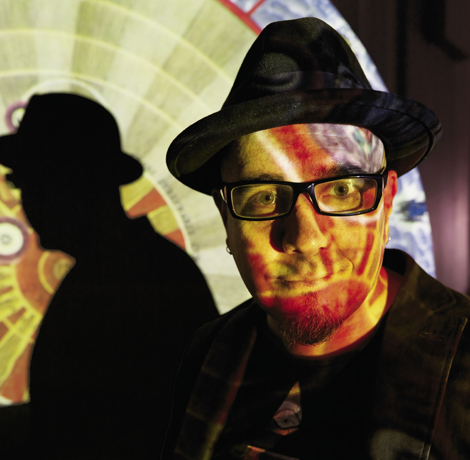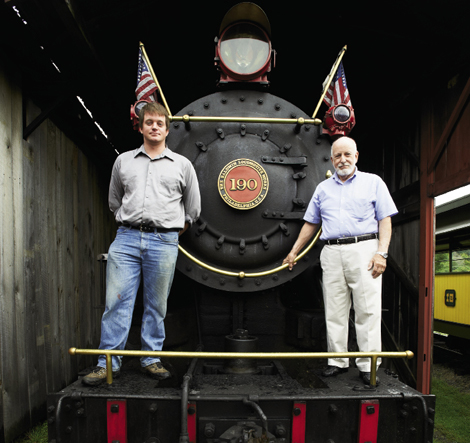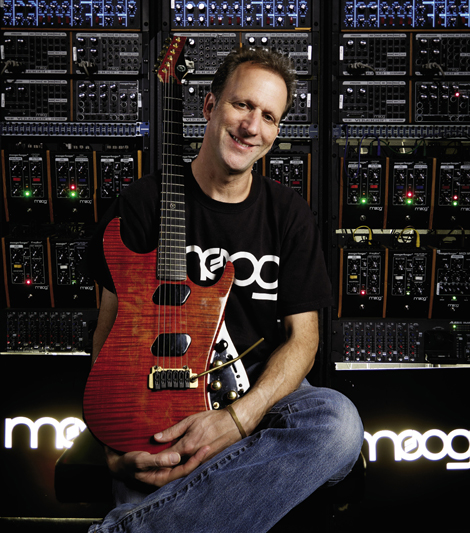Big Thinkers
Big Thinkers:
FOUR visionaries hope to have us commuting via hydrail, pushing the boundaries of sound with electronic instruments, and delving deep to envision solutions to the world’s most pressing environmental problems.
Open your mind to a team’s push for clean transportation, Cyril Lance’s sonic engineering exploits at Moog Music, and David McConville’s big picture immersive technology.

Cosmic Vision
David McConville projects visuals from across the universe to explore the world and its complexities
David McConville could live pretty much anywhere around the globe, and in a way he already does. Any given week might find him in Aspen, San Francisco, or New York, or cities in England or Sweden, to name just a few of the places he’s shared his work in the past few months.
But this veteran global educator decided a while ago where he’d plant roots: in the laid-back, funky climes of West Asheville, where he and his wife, artist and editor Nicole McConville, live in a former bank building.
“I’ve been around here off and on since 1989, when I came to study with Bob Moog at UNCA,” McConville explains. Back then, he was a Georgia-born military brat and budding brainiac trying to figure out his future, and Moog, with his work pioneering electronic music, was McConville’s pied piper. Today, the 40-year-old is one of the world’s leading presenters of big data (we’re talking colossal amounts of information)—in particular, vast visualizations that offer new ways to see the earth and known universe, with a close eye on our planet’s environment.
For most of the past decade, he’s been anchored in Asheville. “I find it to be a very energizing home base,” he says. And though he thinks some folks come here to escape rather than engage, the place is ultimately suited to McConville’s style and worldview. “People try to practice that ‘think globally, act locally’ thing, but we also need to think locally and act globally, and a lot of people here obviously feel that—that we can use whatever experiments we have going on here that have shown success to engage with the global community.”
A perpetual experimenter, McConville juggles many roles. He is the co-founder of The Elumenati, an Asheville-based company that designs projection systems for major art and music festivals, libraries, museums, and science centers; creative director at the Worldviews Network, a data visualization project funded by the National Oceanic and Atmospheric Administration that connects artists, scientists, and students across the country; and president of the Buckminster Fuller Institute, which conducts an annual contest to promote the work of an individual seeking to prompt global changes, along the lines of those explored by Fuller, the late futurist and inventor.
He’s also a student. McConville is close to finishing his Ph.D. in a fittingly unconventional graduate program called the Planetary Collegium, which resides across the span of several universities. (His base in the program is Plymouth University in England.) It’s a transdisciplinary program that allows McConville to pursue art and science in equal measure. In his professional and scholarly work, he says, he’s trying to show “how we can use immersive visualization environments to help people understand the interconnections and interdependence across cosmic, global, and bioregional scales.”
If that sounds fantastical or out of reach, attend one of his virtual tours of the universe, which are modeled from data collected by worldwide authorities, such as NASA and the National Science Foundation, and staged in an inflatable dome. In them, he takes participants from the ground level of our planet to the furthest reaches of the known heavens. It’s an eye-opening experience that illustrates both the expanse of the universe and impact humans have on the earth, in a remarkably relatable way.
At the same time, a session can leave you feeling pretty small, and make you wonder if it’s too late to reverse the tide of climate change. That’s just the sort of complexity McConville wants people to acknowledge and wrestle with.
“Embrace the ambivalence,” he says. “We’re kind of torn between these extremes of love and hate, big and small, human and nature. If I have one big idea, it’s probably this: We try to force everything into a kind of binary logic, but reality doesn’t work like that. There are true contradictions, there are paradoxes—which you can see if you look at things from multiple scales and perceptions.”
Seeing things in new ways isn’t always a simple process, he admits, but he believes it’s a crucial step if humanity is going to achieve "social and ecological resilience."
“One of the most important things we can do right now is to recognize it’s totally within our capacity to think in complex ways,” McConville says. “We need to be thinking in much more complex ways, and we need good examples of what happens when people do that and recognize that we are part of the biosphere. That’s what I like about doing what I do: It brings this stuff up—something that’s not exactly easy to bring up in casual conversation.”
—Jon Elliston

Forward Momentum
ASU research analyst Jason Hoyle and visionary Stan Thompson push clean rail transport into the future
If and when the day comes that railcars deliver passengers and freight while giving off just water as an exhaust, a good bit of thanks should go to Jason Hoyle and Stan Thompson.
Thompson, a retired BellSouth engineer and futurist, and Hoyle, a research analyst at the Appalachian Energy Center at Appalachian State University, are the visionaries behind the annual International Hydrail Conference, that promotes the use of hydrail, or hydrogen fuel cell-driven railcars, as cleaner, quieter alternatives to the diesel trains in use today.
Fuel cells combine hydrogen and oxygen to create electricity. Hydrogen, the most plentiful element in the universe, can store electricity generated from power sources that range from polluting (fossil fuels) to nonpolluting (renewable energy). For instance, solar, wind, or wave energy can be used to create hydrogen, which stores the energy. This gives us around-the-clock access to the power generated by these intermittent energy sources, even when the sun isn’t shining, wind isn’t blowing, or the seas are still.
At the Energy Center, Hoyle studies economics, finance, and policy issues related to energy, primarily in North Carolina but also across the globe. He has presented papers at several of the international conferences, including one held this summer at the Centre for Railway Research and Education at the University of Birmingham in England. Hoyle also maintains what may be the world’s most comprehensive website dedicated to hydrogen fuel cell technology as it applies to railway locomotion (www.hydrail.org).
He was organizing energy conferences for the state when he was contacted in 2005 by Thompson, who had been leading an effort to establish a 30-mile hydrail commuter line on existing tracks between Mooresville and Charlotte.
The Mooresville project began in 2003 to create a fast route to Charlotte and bring jobs to the surrounding area by attracting fuel cell manufacturers. The project could also help the Queen City meet its federal clean air standards. Thompson decided the rail system stood a better chance of securing funding if the technology advanced more quickly and gained wider awareness, developments he could foster by creating an annual conference for the exchange of information and ideas.
In 2005, Hoyle and Thompson presented the first International Hydrail Conference in Charlotte. The event attracted experts from government agencies, universities, and energy and industrial concerns who spoke about the possibilities, applications, and advantages of fuel cell technology. Since the first, six more conferences have been held around the world, welcoming presenters from 15 countries as well as the European Commission and the United Nations.
The connections made at the events have already advanced the movement. They led to the creation of a Ph.D. program in hydrail technology at the University of Pisa, Italy. The program’s first graduate works with Indian Railways. Collaboration among participants helped create a hydrail railcar in Spain that was successfully tested, but not launched because of the country’s fiscal crisis. Work on hydrail has gone on in Denmark, Russia, and Japan, all countries that have sent presenters to conferences.
Last month, Thompson traveled to Hannover, Germany, to promote the technology behind a narrow-gauge hydrail locomotive built by students at the University of Birmingham.
His German host, an entrepreneur, owns two diesel-powered railcars, known as trams in Europe, and plans to replace the engines with hydrogen fuel cells. That project, which would create a commuter line into Hannover, is remarkably similar to the Mooresville-Charlotte proposal yet to come to fruition, Thompson says. The track is about the same length and will serve about the same number of towns.
Hydrail advantages over diesel-powered trains go beyond decreasing pollution, explains Thompson, who coined the term hydrail that has become the industry catchphrase. The cells mean there is no need for expensive overhead electrical lines that power many railway systems and the access to power need not be interrupted. For instance, if India were using fuel cell-powered trains, the cars would have kept rolling in July when the country experienced massive electrical blackouts, Thompson notes. India and China, countries with very little access to oil, face enormous energy costs to supply power to the vast networks of railway lines, utility costs that might be mitigated by converting the systems to fuel cells.
In 2007, Thompson looked at one year’s diesel fuel consumption at Indian Railways, the biggest railway system in the world. Applying that figure to the 21 years it took the world to transition from steam-driven trains to diesel-powered ones, he concluded that beginning the transition to hydrail just one year sooner would prevent 214 million tons of carbon dioxide from being emitted into the air. More than three billion barrels of crude oil wouldn’t have to be extracted from the earth.
As for the Mooresville line, the project is still being championed by former Mooresville Mayor Bill Thunberg, one of the original visionaries on the project and now executive director of the Lake Norman Technology Transportation Commission.
And though much work and public education lie ahead before a line will connect the town and Charlotte, the project deserves its due for moving the global conversation forward.
—Paul Clark

Sound Science
Engineer and musician Cyril Lance is honoring the legacy of Bob Moog by advancing electronic innovation
Cyril Lance didn’t think of his first session with electronic instrument mastermind Bob Moog as a job interview. A mutual friend had simply suggested a meeting of two minds with common interests in music, electronics, and physics. Which meant Lance was duly surprised when he was recruited to join Asheville-based Moog Music, a transition that took him from designing equipment used to “listen” to the sonic signature of lightning to empowering the creativity of musicians.
Sadly, the invitation was prompted in part by Bob’s cancer diagnosis that led to his passing in 2005. “At first, I just thought I was helping out while Bob was going through treatment,” Lance recalls. “But suddenly I found myself immersed in this very dynamic company that represents a very inspiring history.”
It’s not hard to recognize the skills and expertise that intrigued Bob. Lance started out early as a musician, and is a highly regarded guitarist—well-schooled in blues and Americana—who’s fronted his own bands (Outskirts of Infinity) and toured with others (Mel Melton & the Wicked Mojos and Hobex). However, his technical interests led him to work in recording studios during high school and then to a degree in engineering physics from Cornell in 1984—the same degree Bob received in 1965 from the university. Lance then went on to specialize in designing instruments used in the study of atmospheric physics, which took him on a year-long assignment in Antarctica. But a growing desire to determine how his technical skills could apply to music led to the serendipitous meeting with Bob, the man who invented the electronic synthesizer and offered musicians around the world an ever-expanding array of equipment.
Upon joining the company, Lance’s primary focus became continuing Bob’s vision within a corporate culture fueled by creativity. He’s part of a small team devoted to preserving the legacy of the company’s founder through ongoing development and craftsmanship. Reflecting a low-key personality, Lance acknowledges his formal title of senior engineer, though admits he prefers the irreverent one Bob favored: “Chief Technical Kahuna.”
“What continues to amaze me is that some of Bob’s original principles of instrument design are still very much the core of how we approach instruments,” Lance says. “Even after more than 50 years, there’s still so much room for innovation within the confines of his design philosophies.”
According to Lance, there’s never a shortage of potential projects, with generally four to five instruments in development at any time. The creation of new equipment is never a simple linear process, but involves intense brainstorming, design, and hands-on experimentation and testing by the Moog collective. What results often is very different from the original vision due to the artistic, technical, and business requirements, and even the mystery of the circuit board itself. “We can know in theory and design how a circuit works,” Lance says, “but until you play with it and listen to it, you can’t know if it’s got the magic.”
Inspiration and guidance come from three sources. There’s the cultural influence that suggests what instruments are developed based on demand from musicians. As an example, Lance points to the dramatic impact the sound-bending experimentation of the 1960s psychedelic era had on synthesizers.
The continuing evolution of technology also fuels new ways to do things. This approach is aptly demonstrated by Moog Music’s Animoog, a cutting-edge digital synthesizer application driven by the possibilities presented by the iPad. For Lance, that effort mirrored Bob’s belief in examining new technology and considering what innovative musical tool could be created. Lance also stresses the importance of actively collaborating with musicians to understand how they’re utilizing technology. He underscores the contribution of the Animoog to what he terms the ongoing democratization of music.
Finally, there are new visions based on constant examination of the trends in musical performance and production, even a musician’s stated desire to achieve a new sound. Such was the case with the Moog Guitar, which was launched in 2008. “Here’s an instrument that’s been around for 500 years, but the basics and physics of the instrument really haven’t changed,” Lance says. “The Moog Guitar’s inspiration was to view the guitar string as an oscillator, much like in one of our synthesizers, and then modulating that vibrating piece of metal.”
It was an opportunity to explore something completely new, and the Moog crew knows it’s virtually impossible to envision what musicians are going to create with it—but that’s part of the fun. The ultimate payoff, however, is always the same. “Our most gratifying moments come when we hear a musician create something beautiful and unexpected with our instruments,” Lance says. “That generates even more creative energy that then goes into our commitment to further empower individuals to make music.”
—Gary Carter
